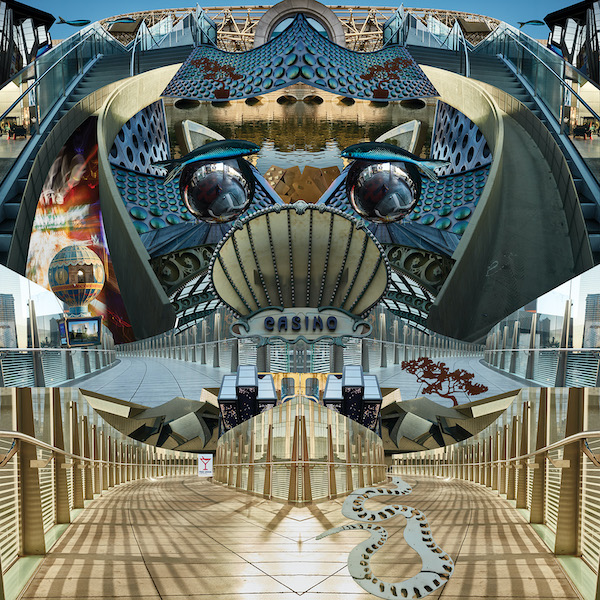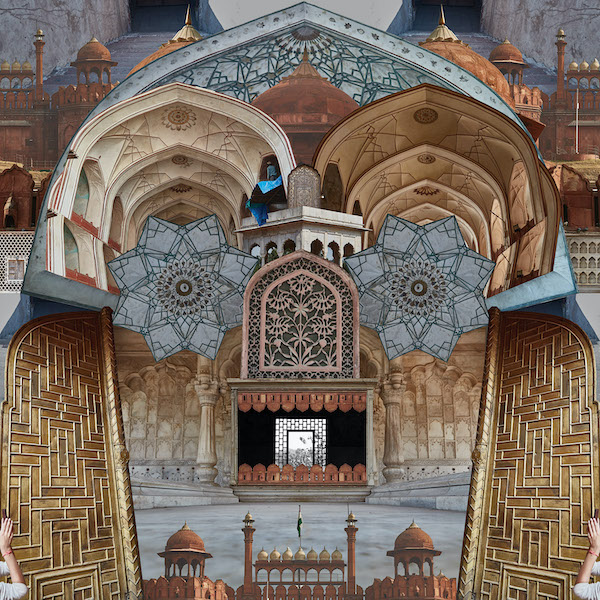Revealing Faces of Places: Dhiren Dasu’s Unusual Artistic Presentation at the Santa Monica Art Museum
- The breakout “Simulacre” series of digital collages morph his photos of architecture and objects into startling entities.

Enter the space and you are surrounded by faces, watching you from every wall. Stand in the center, and swivel slowly, sweeping your gaze over each human, animal, and android, and notice the multitude of interconnected components it’s made of, like complex machinery.
Dhiren Dasu’s digital art in his “Simulacre” (meaning: something closely resembling another) series is an artistic feat of deconstructing photos taken on his travels around the world and reconstructing them into finely wrought collages that look like faces.
Of the whopping 85 pieces he has created in this series, 64 are included in his coffee-table book to be released end of February, and 15 are on display at the Santa Monica Art Museum through March 1.

Emirates Palace, Abu Dhabi. Inset, Dhiren Dasu (photo by Nick Berardi).
The nearly five-square-foot images, rendered in high megapixels, are a bold and whimsical presence, commanding attention. Just stand and stare momentarily and be dazzled by the composition and color. Spot iconic structures in the works such as the Disney Concert Hall, the winged marble horses of the Caesars Palace casino, the Shard of London, the massive banyan tree of Maui, and be delighted, like playing the game of ‘I Spy.’

Scan the bar code, launch the augmented reality app on your phone and zoom-in on the details. Step closer, take the time to unpack the rigorously executed work, and reap rich rewards of meaning.
Do the faces represent the digital surveillance omnipresent in our lives? Perhaps. The pieces are layered and interpretative. Take the piece “Snakes and Dollars” for example, a face of Las Vegas. Composed of the gilded architecture of Sin City casinos, it hints at the mirage that lures, then leaves you empty-handed.
Dasu, also a poet, has crafted haiku commentaries for each piece, placed on the wall label alongside. Fools gold…, he cautions about the Vegas piece, …House always wins. His art offers an unusual presentation of familiar places. His poetry aids our understanding of it.
It’s All in the Architecture
Drawn to architecture by its geometry, texture, and history, Dasu amassed thousands of photos on his travels through India, Asia, Europe, the Middle East and North America. A range of architecture from ancient to modern of palaces, temples, forts, skyscrapers, landmark public places even planes, trains, airports and hotels are captured.

While playing around with shots from his Seattle trip in Photoshop, seven years ago, a face emerged from the juxtaposition of images, like the spirit of the place revealing itself, thus giving rise to his oeuvre. He then traveled specifically to gather material for his portraits of places. Yet, his pieces start without a preconceived idea of the final visual, lending the process of assembling them the thrill of discovery.Each image is created from photos of a single city or building generally shot on a single day.
Dasu cuts out parts from photos, sizes and positions them. He shuns all other digital trickery.
Entire buildings and their features such as arches, towers, domes, banisters, railings, doors, windows, walls, courtyards, artifacts, and atriums are employed to form facial features and mise en scene.
He uses the classic surrealist trope: juxtaposing images that don’t go together to create something unfamiliar, even unsettling.
From the photos, Dasu takes the elements that interest him and moves them around, his Photoshop files bulging with fifty sometimes a hundred layers, until the entity that emerges satisfies his esthetic sense and conveys the character of the place.
“Architecture is standing fine art. It reflects all the cultural baggage, prejudices and knowledge of the people who created it and the culture and time it evolved in,” he says.
Most of the faces appear masculine because architecture and construction are male-dominated, he explains. One of the three feminine entities in the book is the face of the Emirates Palace Hotel in Abu Dhabi. The piece is titled “Unveiled Beauty.” Moroccan woodwork banisters become the woman’s chic bob, and also her veil, partially pulled back to reveal her potential and beauty.
“Simulacre” is about the power of perception and our ability to manipulate information and our sensory input to match our preconceptions, Dasu says.
The Book: An Insight
“Simulacre” the book reflects the full spectrum of the series. Through it, Dasu succinctly shares his personal experience of these places and the themes in his subconscious that became clear to him as the body of work began to coalesce and the poetry, triggered by the images, spilled out. It allows the viewer to peek beneath the surface and appreciate his work.
A major theme is colonialism and the increasingly aggressive consumerism it spawned. Colonialism’s impact on India is amply illustrated. “Diamonds are for never” is a piece depicting Hyderabad’s Golconda Fort. Dasu’s poetry alludes to its facets (Golconda’s diamond mines and the Koh-i-noor once stored in its vaults) that drifted off to the west, leaving behind an empty shell. The “Lal Quila” of Delhi, which housed Raj’s offices and army, was subjected to plunder, rinse, repeat. He then tells us where most of the booty went.
“And Echoes of Empire: More loot” is the face of a British museum decked out with exquisite bronze Buddhist idols, European marble sculptures and Islamic arches and pillars.
Yet, Dasu questions whether the artifacts would have survived the apathy of their cultures had the foreigners not carried them away. Such irony is abundant in his work. His understanding of history and sharply critical eye bring other layers of meaning to the fore.
Artworks are organized thematically under evocative chapter titles such as “Egotourism” and “The Museoleum.” Filed under the latter, “Opiates are the Opiates of the Masses,” is a jab at the Guggenheim, the bastion of art that is also a beneficiary of Purdue Pharma’s fortune raked in by precipitating the opioid crisis. The face depicted is a tiger lying in wait. The spirals of Guggenheim, the iconic Frank Lloyd Wright structure, are its stripes, the oculus, and its eyes. The haiku reads:
Endemic epidemics abound
Malevolent eyes size up the prey
Lives swallowed whole
Spiritual musings come to the fore in “Desire: For Whom the Bell Tolls,” a face of the Wat Rong Khun art exhibit in Thailand. Its sculpture of the outstretched ‘hands from hell’ are prevented, by the roiling upheaval of desire, from reaching the state of meditating figure in the eye.
“Warrior | Monkey | God” is Dasu’s homage to his favorite superhero, Hanuman, emerging helmet-clad from the photos of Rajasthani forts and temples. This is the only work with recognizable humans in it. In the eyes of the sadhus in the foreground, Dasu saw the wisdom of the ages. They were neither tourists nor consumerists, he says, they needed to be in this picture.
Influences
Growing up in Iran and Kuwait in the 1970s and 80s where his anesthesiologist father worked, completing high school in Hyderabad, then moving to California for his undergrad studies and settling here, Dasu carries cross-cultural perspectives that his art reflects.
Pursuing a degree in finance at San Jose State, he knew by his senior year he wasn’t cut out for it. His interest leaned more toward his minor in communication. He had found computers a versatile tool for his visual art and the dot com era made his graphic design, web design, animation and multimedia skills marketable.
Since the late 90s, he has been working as a digital media developer for tech companies and artist clients. In college, Dasu discovered Salvador Dali, the Spanish surrealist master, renowned for his trippy landscapes. Dali’s work remains the strongest influence along with the exquisite geometric art of Dutch artist M.C. Escher.

Having no formal training in art, Dasu credits LA-based surrealist artist Penny Slinger, acclaimed for her exploration of the feminine psyche through collage, photography, painting, drawing, performance and video, with teaching him almost everything he knows about technique, perception and artistic expression. Both have collaborated on Slinger’s work for two decades, with Dasu handling her digital work. One of their projects is a scenography of a 2019 Christian Dior Couture show in Paris.
In the book’s Afterword, Slinger describes the pieces in the “Simulacre” series as giant jigsaw puzzles that form a grand new design. “The deeper you look into them the more they reveal…He skillfully brings sentience to the inanimate,” she writes.
Dasu has also been working with Derek Boshier, a founder of the British Pop Art movement who has written the foreword for the book. Boshier calls Dasu’s art “strong and original… These faces speak to you of many different human conditions.”
“In this digital age when we all are constantly being watched, who is watching the watchers except artists like Dhiren Dasu,” artist Bil Brown writes.
Works from the “Simulacre” series were showcased in group shows at galleries in the LA area, Dubai and the UK. Many pieces in the exhibit and the book are augmented reality enabled through the Hoverlay app. Viewers can experience the micros of the artworks by zooming in on their devices. “Simulacre” series is on display until March 1, 2023, as part of the Looking West show at the Santa Monica Art Museum, 1219 Third Street Promenade Santa Monica, CA 90401. https://www.santamonicaartmuseum.com/
Preeti Chandan worked as a journalist for 20 years in India and the U.S. Her articles on diverse subjects including the arts have appeared in The Press-Enterprise, The Champion, The Times of India, India Today, India Abroad, India West, G magazine, and others. She now works in sales and marketing and digs her annual gig as a publicist for the Indian Film Festival of Los Angeles.


